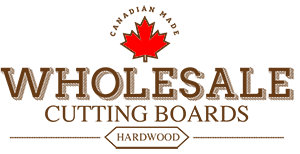Blog
Top Trends in Wholesale Cutting Boards 2025
1. Sustainability Becomes Mainstream
The people are more into environmental awareness nowadays, so sustainability is no longer merely a buzzword, but a priority in the minds of the consumers. This affects the industry with cutting boards at various levels, whether it is:
- Eco-Friendly Materials: Bamboo cutting boards are produced because the material is renewable. Unlike traditional hardwoods, which take much time to grow, bamboo grows very fast and requires less care to grow; therefore, it is one of the favorite materials for the eco-minded consumer. FSC-certified woods, such as Canadian maple, also guarantee that products are sourced responsibly.
- Recycled Materials: Some manufacturers are trying out cutting boards made from recycled plastics or composite materials. These options have a certain appeal to customers who look for new, ‘green’ alternatives.
- Local Sourcing: Buying locally sourced products, like Canadian-made cutting boards, cuts down on transportation emissions and supports local economies. Touting these benefits with your wholesale offerings can go a long way in attracting those customers who consider sustainability when making purchasing decisions.
2. Multi functional Designs
The modern consumer expects variety in their kitchen utensils, and cutting boards are not left out. Multifunctional designs change the way one perceives and uses cutting boards in the following manner:
- Cut and Serve: Big boards work both as a cutting surface and an elegant serving plate for homes and restaurants, serving charcuterie spreads perfectly.
- Built-In Features: Cutting boards with integrated juice grooves, measurement guides, or collapsible strainers make life easier for busy home cooks. Selling these advanced designs at wholesale prices could set your business apart.
- Compact and Modular Options: Convenience and space-saving designs are in demand as more people move to urban living. Compact boards or modular sets that can be stored or stacked efficiently are ideal for small kitchens.
3. Smart Technology in Kitchen Utensils
Smart technology has invaded kitchen tools—right from cutting boards to the simplest gadget in the kitchen. Though still a niche market, these are some trends to look out for in 2025:
- Antimicrobial Properties: Cutting boards featuring antimicrobial action through either the natural properties of wood, such as bamboo, or through progressive coatings provide additional hygiene during food preparation. These types of boards appeal to health-conscious customers and food service providers alike.
- Digital Features: Some cutting boards already come with digital scales, timers, and app connectivity. While these are high-end products, the more the trend catches on with tech-savvy consumers, the wider the doors that open for wholesalers targeting niche markets.
4. Personalization and Customization
Personalized cutting boards continue to trend strongly, especially for gifting and branding purposes:
- Laser Engraving: From corporate logos to personalized messages, laser engraving adds value to otherwise standard products. Businesses and individuals alike are starting to seek out customized cutting boards for promotional events, weddings, and housewarming gifts.
- Resin Art and Unique Finishes: Resin-enhanced cutting boards exude aesthetic appeal, marrying functionality with fashion. These wholesale catalog additions will give customers reason to present their kitchen utensils as statement pieces.
5. Durability and Hygiene
Cutting board users worry about durability and hygiene—and new developments take care of this need for users quite well:
- Hardwoods as the Gold Standard: Canadian maple, walnut, and cherry are still preferred because of their toughness and fine grain that ensures minimal wear on knives. These woods also have natural resistance to bacteria, further stepping up hygiene.
- Dishwasher-Friendly Options: While wood remains a popular choice, some customers want easy-to-clean boards for dishwashers. Selling a mix of materials, including quality plastic or composite boards, can appeal to these preferences.
- Knife-Friendly Designs: Cutting boards with surfaces that guard the edges of knives are fast becoming popular. These boards appeal to professional chefs and cooking enthusiasts.
6. Global Influences and Cultural Trends
Global cuisines and cultural changes also impact the cutting board market:
- Ethnic Cuisine Boards: Specialty boards, such as sushi-making boards or bread-cutting boards with grooves to catch crumbs, appeal to customers seeking more specialized tools.
- Luxurious Materials: Exotic hardwoods for cutting boards are some of the newer high-end kitchen accessories. Carrying high-end options in your wholesale line can attract premium buyers.
Thriving as a Wholesaler
To thrive in this shifting market, wholesalers must stay ahead of trends. Here’s how:
- Diversify Your Product Line: Stock a mix of traditional and innovative cutting boards, ranging from eco-friendly to multifunctional and tech-enhanced.
- Educate Your Customers: Highlight sustainable practices, unique features, and benefits in product descriptions, blog posts, and marketing materials.
- Leverage Technology: Use data analytics to understand customer preferences and adjust inventory. Offer online customization tools for personalized orders.
- Collaborate with Retailers: Partner with retailers to showcase your products in-store or online. Highlight trends to appeal to contemporary customers.
Conclusion: Meeting 2025 Demand
The features of sustainability, innovation, and versatility will define the cutting board market in 2025. Wholesalers can establish themselves as industry leaders by embracing these trends. With designs focused on eco-friendly materials, multifunctionality, or smart technology, staying updated on consumer preferences will ensure continued growth and success in this dynamic market.
